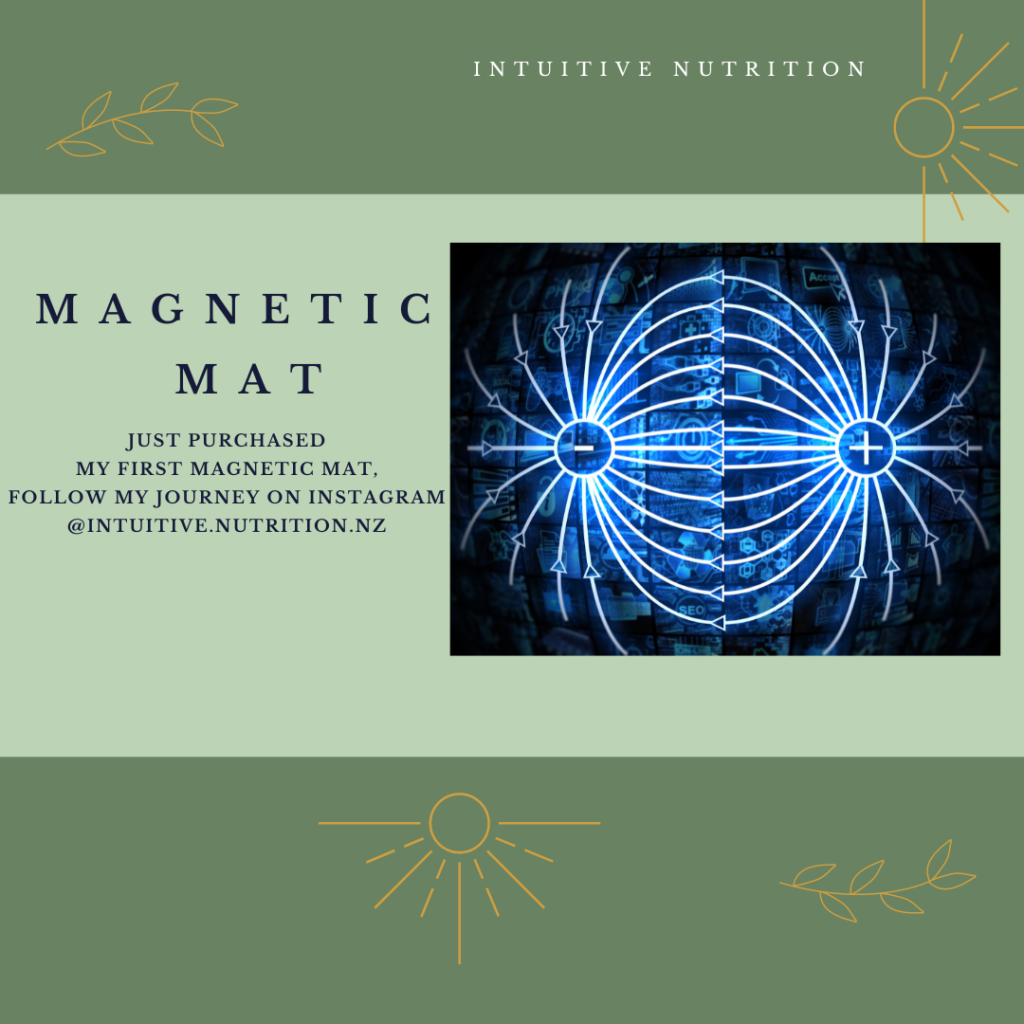Magnetic Mat, how can magnetic therapy support your wellbeing?
So, I just started my magnetic mat journey after purchasing one at the Mangawhai Community Market last weekend. I’m really curious to see how it can support my wellbeing, especially since I sometimes get sinus headaches and tension headaches. I’ve heard that magnetic therapy could potentially help with these issues, so I’m excited to give it a try and see if it makes a difference.

Now, before you start your own magnetic journey, there are a few things you should know. Below is all you need to know before starting your magnetic journey, as this therapy is not for all! but can greatly benefit people. Always listen to your body and gradually use your mat to allow your body to adjust start with 30 minutes then an hour and so on.
Magnetic mats are a type of therapy that uses magnets to create a magnetic field that is said to have a positive effect on the body. These mats are made of a series of magnets that are placed inside a flexible fabric cover that can be laid on a flat surface such as a bed, pillow case, office chair, couch or floor.
What are Magnetic Mats?
Magnetic mats are mats that use magnets to create a magnetic field. These mats are made of a series of magnets that are placed inside a flexible fabric cover that can be laid on a flat surface such as a bed, office chair, couch or floor. The magnets used in magnetic mats are usually made of neodymium or ferrite, and they are often arranged in a specific pattern or polarity.
How Do Magnetic Mats Affect the Body?
Magnetic mats are said to have a positive effect on the body by creating a magnetic field that interacts with the body’s own magnetic field. This interaction is thought to stimulate the body’s natural healing processes, such as increased blood flow, reduced inflammation, and improved cell regeneration. The magnetic field is also believed to have a calming effect on the body, which can help to reduce stress and improve sleep.
Benefits of Magnetic Mats
There are several potential benefits of using magnetic mats, including:
- Improved Circulation: Magnetic mats are believed to help improve blood flow by increasing the diameter of blood vessels and reducing inflammation. Improved circulation can help to reduce pain, improve healing, and promote overall health.
- Pain Relief: Magnetic mats are thought to help relieve pain by reducing inflammation and stimulating the body’s natural pain-relieving mechanisms.
- Reduced Inflammation: Magnetic mats are believed to help reduce inflammation by increasing the production of anti-inflammatory cytokines and decreasing the production of pro-inflammatory cytokines.
- Improved Sleep: Magnetic mats are thought to have a calming effect on the body, which can help to improve sleep quality and reduce insomnia.
- Migraine/headache Reduction; In the two studies below it was seen using magnetic therapy reduced the frequency and severity of migraines.
Contraindications of Magnetic Mats
While magnetic mats are generally considered safe, there are some contraindications to be aware of. Magnetic therapy should not be used by individuals who have:
- Implanted Medical Devices: Magnetic fields can interfere with the function of implanted medical devices such as pacemakers, defibrillators, plates and cochlear implants.
- Pregnant Women: The effects of magnetic therapy on pregnancy are not well understood, so pregnant women should avoid using magnetic mats.
- Individuals with Bleeding Disorders: Magnetic therapy can potentially increase the risk of bleeding in individuals with bleeding disorders, so caution should be taken.
History of Using Magnets in Healthcare
The use of magnets in healthcare dates back to ancient times. The Greeks and Egyptians used lodestone, a naturally occurring magnetic mineral, for its healing properties. In the 16th century, Paracelsus, a Swiss physician, used magnets to treat a variety of conditions. In the 19th century, magnetic therapy became more popular, and physicians began using magnets to treat a wide range of ailments, including headaches, arthritis, and rheumatism. Today, magnetic therapy is still used by some healthcare practitioners to treat a variety of conditions.
Studies on Magnetic Mats
There have been several studies conducted on the use of magnetic therapy for various conditions. Here are two studies that provide insight into the potential benefits of magnetic mats:
- A randomized controlled trial published in the Journal of Alternative and Complementary Medicine found that magnetic mattress pads improved sleep quality and reduced pain in patients with chronic low back pain. The study included 80 participants who were randomly assigned to either a group that used a magnetic mattress pad or a group that used a placebo pad. After 4 weeks, the group that used the magnetic pad reported significant improvements in sleep quality and pain compared to the placebo group.
Link to study: https://pubmed.ncbi.nlm.nih.gov/18667017/
- Another study published in the Journal of Magnetic Resonance Imaging found that magnetic therapy may help to reduce inflammation in the brain. The study included 10 healthy participants who underwent magnetic therapy for 15 minutes. The researchers found that magnetic therapy reduced inflammation in the brain, as measured by changes in the levels of certain biomarkers.
Link to study: https://pubmed.ncbi.nlm.nih.gov/28426970/
Studies of Magnetic Therapy for Migraines
Study Title: “Magnetic stimulation for migraine: a randomized, double-blind, placebo-controlled trial”
Authors: Lipton RB, Goadsby PJ, Cady RK, Aurora SK, Grosberg BM, Freitag F, et al.
Journal: Cephalalgia
Year: 2010
Summary: This study was a randomized, double-blind, placebo-controlled trial conducted to evaluate the efficacy and safety of transcranial magnetic stimulation (TMS) in the prevention of migraine attacks. The study involved 164 patients who were randomized to receive either active TMS or placebo treatment for 12 weeks. The results showed that active TMS was significantly more effective than placebo in reducing the number of migraine days per month, the severity of pain, and the need for rescue medication. The authors concluded that TMS is a safe and effective non-pharmacological treatment option for migraine prevention.
Study Title: “A randomized, double-blind, sham-controlled trial of magnetic therapy for migraine”
Authors: Holzer G, Ganslandt O, Wober C, Wessely P, Hausmanninger H, Wurm G, et al.
Journal: Cephalalgia
Year: 2004
Summary: This study was a randomized, double-blind, sham-controlled trial conducted to evaluate the efficacy and safety of magnetic therapy in the treatment of migraine. The study involved 42 patients who were randomized to receive either active magnetic therapy or sham treatment for four weeks. The results showed that active magnetic therapy was significantly more effective than sham treatment in reducing the frequency and intensity of migraines, as well as the need for rescue medication. The authors concluded that magnetic therapy is a safe and effective treatment option for migraine.
Both of these studies were well-designed randomized controlled trials, which are considered the gold standard for evaluating the efficacy of treatments. The first study was conducted by a team of researchers led by Richard B. Lipton, MD, from the Montefiore Headache Center and the Albert Einstein College of Medicine in New York, USA, and Peter J. Goadsby, MD, from the University of California, San Francisco, USA. The second study was conducted by a team of researchers led by Gerhard Holzer, MD, from the Medical University of Graz, Austria.
Where to Buy Magnetic Mats in New Zealand
Here are two popular online stores where you can purchase magnetic mats in New Zealand:
Bodymagnetix: Bodymagnetix offers a range of magnetic therapy products, including magnetic pads, wraps, and jewellery. They also offer free shipping on orders over $100. Bodymagnetix: https://www.bodymagnetix.co.nz/
BioMagStore: Bio Mag has a large range of magnetic therapy products, including a wonderful petmag for your pet. https://www.biomag.co.nz/
The information provided in this article is for educational and informational purposes only and should not be construed as medical advice. The use of magnetic therapy and magnetic mats should be approached with caution and only after consulting with a qualified healthcare professional. Magnetic therapy may not be suitable for everyone, particularly those with implanted medical devices, bleeding disorders, epilepsy or seizures, or pregnant women. The author and publisher of this article disclaim any liability for any adverse effects resulting from the use of magnetic mats or magnetic therapy.
Regenerate response


